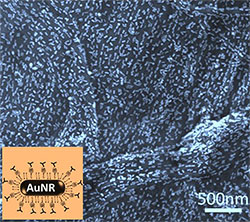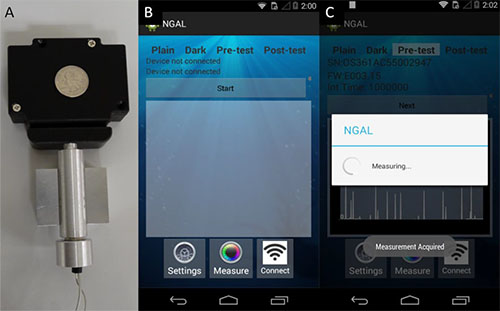


Posted December 5, 2014
Principal Investigator (PI): Srikanth Singamaneni, Ph.D., Washington University
Co-PIs: Jeremiah J. Morrissey, Ph.D. and Evan D. Kharasch, M.D. Ph.D., Washington University
 1. What is the most important thing that stakeholders should know about your research?
1. What is the most important thing that stakeholders should know about your research?
Our goal for this Peer Reviewed Cancer Research Program Fiscal Year 2010 Translational New Investigator Award is to design and demonstrate a simple and inexpensive urine test that can be performed in a physician's office for the detection of kidney cancer at a very early stage. The test measures the quantity of two different proteins (namely aquaporin-1 and adipophilin) present in the urine of a person. We recently found that higher amounts of these proteins are present in the urine of persons with kidney cancer compared to healthy volunteers. However, detection of these proteins using current methods is expensive and time-consuming. We aim to develop an inexpensive technology to quickly measure the quantities of these proteins. The envisioned technology is based on common filter paper loaded with biofunctionalized gold nanorods, which upon binding to the target proteins in urine will result in a color change of the paper. The color change can be detected and measured using simple hand-held spectrometer or ideally a smart phone with an inexpensive add-on module.
2. How did you arrive at this information or approach?
My co-PIs on this project (Dr. Kharasch and Dr. Morrissey) and I have identified two proteins in urine that can serve as biomarkers for non-invasive detection of kidney cancer. To benefit a large set of the population, we asked ourselves if we could develop a simpler technology that is not only cheaper and faster but also eliminates the need for highly trained personnel so that the test can be performed in a physician's office. With such goals, we hypothesized that gold nanorods, which are known to be highly sensitive nanosensors, if successfully integrated with a paper-based technology, could be a powerful way to make this non-invasive detection platform available to a broad population or even incorporate this into a routine health physical.

Figure 1: Scanning electron microscope image of common laboratory filter paper adsorbed with biofunctionalized gold nanorods.
3. What is the next step to bringing your research closer to helping cancer patients?
We believe that we have a powerful platform that can be used for screening large populations for kidney cancer. To take this technology forward, we plan to simplify the readout technology. So far, we have been using standard bench-top spectrometers. These instruments might not be optimal for clinical lab settings. We plan to simplify this by designing and building a hand-held spectrometer that can be operated through a smart phone. The entire assay can be performed using a mobile phone, and the results can be documented using a software application (app) designed for the purpose. We have already made some progress in this direction and efforts are underway to test it on real urine samples (Figure 2).

Figure 2: (A) First prototype of the smart phone based spectrometer (B and C) Screen shots of the app running on an AndroidTM smart phone.
4. Is there any other information that you think readers should know about your work?
We are the first team of researchers to introduce this "bioplasmonic paper" as a sensing platform. While our efforts so far have been primarily focused on kidney cancer, the technology, if successful, can have broad application in early detection of other forms of cancer, food safety, and environmental monitoring.
Links:














